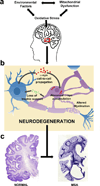Multiple system atrophy: a clinical and neuropathological perspective
- PMID: 21962754
- PMCID: PMC3200496
- DOI: 10.1016/j.tins.2011.08.003
Multiple system atrophy: a clinical and neuropathological perspective
Abstract
Multiple system atrophy (MSA) is a neurodegenerative disease involving motor abnormalities that include akinesia, rigidity and postural instability. While improved diagnostic criteria have aided the accurate diagnosis of MSA, our understanding of the neuropathological aspects underlying MSA was bolstered by the identification of α-synuclein (α-syn) as the primary constituent of the abnormal protein aggregates observed in the brains of MSA patients. The generation of transgenic animal models of MSA coupled with an increasing understanding of the biochemical structure and function of α-syn has highlighted a number of key pathological pathways thought to underlie the neurodegeneration observed in MSA. This review summarizes key findings in the field, discusses current areas of debate, and describes current experimental approaches towards disease-modifying therapies.
Copyright © 2011 Elsevier Ltd. All rights reserved.
Figures



References
-
- Selkoe D. Amyloid β-protein deposition as a seminal pathogenic event in AD: an hypothesis. Neurobiol.Aging. 1990;11:299.
-
- Vonsattel JP, et al. Huntington's disease - neuropathology. Handb Clin Neurol. 2011;100:83–100. - PubMed
-
- Kahle PJ. alpha-Synucleinopathy models and human neuropathology: similarities and differences. Acta Neuropathol. 2008;115:87–95. - PubMed
-
- Geser F, et al. The European Multiple System Atrophy-Study Group (EMSA-SG) J Neural Transm. 2005;112:1677–1686. - PubMed
Publication types
MeSH terms
Substances
Grants and funding
LinkOut - more resources
Full Text Sources
Other Literature Sources
Miscellaneous

